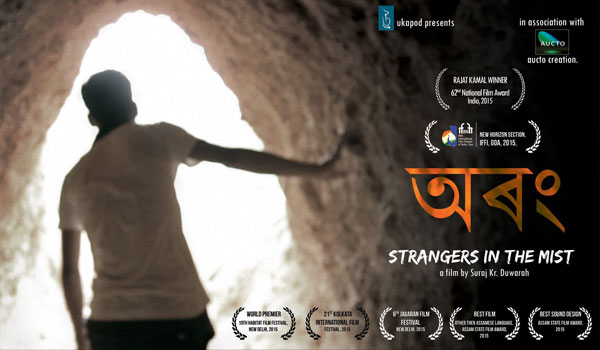Films from the North East involve going back in history and also engage in a continuous negotiation with contemporary forces, such as globalisation, neoimperialism, and power politics within Indigenous communities.
Cinema from the North East foregrounds discursive gaps between lived Indigenous practices and non-Indigenous reception of the same, as well as directs our attention to the growth and development of new ways of understanding the world from the perspective of Indigenous discourses. Jyotiprasad Aggarwala’s Joymoti, the story of the Ahom princess who sacrifices her life for democracy, was released in 1935. Combating the neo-imperial presence of institutionalised studios in Bombay and Kolkata, Aggarwala wrote: “In India, Indian films must be made…otherwise it would be impossible to put an end to the suction of money by foreign films…For sometime, the Assamese people, instead of comparing an Assamese production with Bengali, Hindi or American films, must take an Assamese film eagerly and endearingly as one belonging to the first grade despite its lack of quality if there be any.” (cited in Mazid 2007: 37-8)[1]. Aggarwala would return to Assam after training in Germany’s UFA studios to establish the Chitralekha Moviestone Company at Bholaguri Tea Estate in Assam. People involved for the movie production belonged to village communities in the region. However, despite the long and complex multilingual history of cinema from the North East, one seems to remember only a Pramathesh Barua,a S.D. Burman, a Bhupen Hazarika, or a Seema Biswas as scattered names from the North East pantheon. What is forgotten is the conscious, continual process of ‘de-territorialising diversities’, closely connected to the concept of bringing to the centre the fluid cultural borders and boundaries and ‘closed’ spaces”[2].
Mishing, Karbi, Kokborok, Bodo, Manipuri, Assamese are just some of the languages in which North East cinema has been made. Complex cinematic texts connect the political and the public, moving beyond the mainstream media discourse on insurgency and military intervention.
For instance, AFSPA, 1958 written and directed by Haobam Pebam Kumar in 2006, is a documentary movie, which focuses on the plight of women from Manipur in the aftermath of the Manorama Devi AFSPA episode. On 10 July 2004, Thangjam Manorama had been picked up from her home in Bamon Kampu Village in Imphal East District by the 17thAssam Rifles on the basis of her alleged connections with the People’s Liberation Army. The next morning, her bullet-ridden corpse was found along with semen marks on her skirt suggesting rape and murder. It led to widespread protests and a group of women belonging to the “Meira Paibi” or “Torchbearers” demonstrated in front of the 17th Assam Rifles by stripping naked and calling on the army to rape them as Manorama had been raped. AFSPA, 1958 offers a sustained and poignant diary of the events of 10th July 2004 and its consequences which highlight failure of justice and the controversies around AFSPA.
The deprivation of land, forced migration and the eradication of Indigenous ways of life have been integral to narratives from the region. Joseph Pulinthanath, with his origins in Kerala, has spent much of his time in the North East. In 2008, he made his second feature film in the Kokborok language entitled Yarwng or Roots. Located in the idyllic banks of the Raima and the Saima, the movie revolves around a Hydel Project in Tripura in the 1970s, which led to a large-scale displacement of Indigenous peoples. While the film is emphatic on the erasure of Indigenous identity, Soumitra Debbarma, a researcher in History from Tripura University, feels:
“Sadly, there is hardly any audience for such films as Indigenous youth seem to be increasingly assimilated within so called main stream cultures, ignoring our sense of history and culture. Such films need to be watched within Tripura in order to initiate the process of healing and also beyond Tripura in order to overcome stereotypes and rethink epistemological assumptions.”
Manju Borah has directed eight movies in Assamese, Mishing and Bodo and has also received several international and national awards. However, for her last film entitled Dau Huduni Methai (Song of the Horned Owl, 2015) based on the effect of Bodo insurgencies on villagers, Borah expressed her apprehensions: “I don’t think it will ever have a theatrical release. With most theatres favouring mainstream cinema and even audiences, it’s impossible for films from other languages to make it to cinemas…. It’s really sad that only Hindi and English films manage to enjoy theatrical release. What about other language films? We produce films in so many languages but why the focus is always on Bollywood?”[3] Borah’s 2012 film Ko: Yad (A Silent Way) in Mishing revolves around the life of Pokkam from the Mishing community. Based on Anil Panging’s novel Ko: Yad that was published in installments in the weekly Assamese daily Xadin, the movie won the Best Assamese Mishing Film Award along with the Best Cinematographer award for Sudheer Palsane at the 60th National Film Festival in 2012. The story of a driftwood collector and the betrayal that he faces from his family, creditors and the river itself is emblematic of the human condition.
“Returning home” is a significant trope of much of contemporary films from the North East, given the pains of alienation, exile and a diminishing sense of ‘homeland’. It becomes crucial to be able to return to the geographical space of the homeland, before one can enter the process of reclaiming identities and attempt a completion of performance. Crossing Bridges (2013) directed by Sange Dorjee Thondok is the first feature film in Shertukpen, one of the languages of Arunachal Pradesh. The movie tells the story of middle aged Tashi, who returns to his village after losing his job as a web designer in Mumbai. In the long wait for new openings in the city, Tashi experiences the worldviews of his people, which changes his perception of life and aspirations. In an interview, Thondok, a graduate from the Satyajit Ray Film and Television Institute, Kolkata, asserts that to make a film in Shertukpen was a conscious decision and he also divulges “but I didn’t have the fear of it not reaching the audience as the basic idea of making the film in my language was to preserve it in whatever small way and at the same time show rest of the world, which knows very little about our culture and way of living.”[4] Tashi, the protagonist, would like to ‘get out’ of home, which he feels does not have anything to offer. Yet, through his days of unemployment, he connects, albeit unwillingly with his ageing parents, friends, and children at a school where he decides to teach for a while. He realises that for them, Mumbai is ‘foreign land’, while for him, his village and its people have become ‘foreign’. Yet, he is haunted by remarks and questions like “You seemed to have lost our taste for butter tea”, or “Why don’t the outside world know about us?” The movie is a beautiful kaleidoscope of little surprises in the pristine valleys of Arunachal Pradesh, yet rooted in real questions on how important it is to “stay back”.
Orong directed by Suraj Kumar Duwarah won the Best Feature Film Award in Rabha at the 62nd National Film Festival. The story of the teenager Rasong and his struggle to live life in his own terms may be juxtaposed with that of the elderly Apu, a former ‘head hunter’ and his travails in the dense forests of Nagaland, in Nilanjan Dutta’s The Head Hunter (2015) in the Wancho language.
Films from the North East involve going back in history and also engage in a continuous negotiation with contemporary forces, such as globalisation, neoimperialism, and power politics within Indigenous communities.
Directors from the North East are establishing a new path of Indian film production. Through a lyrical use of nature and locations, and a discussion of hard-hitting issues pertinent to the region, they weave tales of wonder and woe, producing profound art, which ‘returns’ the gaze.
Citations:
[1] https://montymajeed2.wordpress.com/2014/09/30/121-interview-sange-dorjee-thongdok/ Accessed on 22 July, 2016.
[2] http://indianexpress.com/article/entertainment/regional/dont-think-my-film-will-make-it-to-theatres-manju-borah/ Accessed on 22 July, 2016
[3]Mazid. A. “Jyotiprasad and Joymoti:The Pioneer and the First Assamese Film” in Barpujari M. and Kalita G. Eds. Perspectives on Cinema of Assam. 2007. Guwahati: Gauhati Cine Club, 29-50
[4]. Prem Kumari Srivastava and Gitanjali Chawla. Eds. De-territorialising Diversities: Literatures of the Indigenous and Marginalised. 2014. New Delhi: Authorspress, 21.















